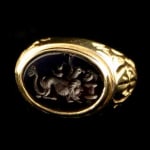Gold Ring Featuring a Classical Revival Garnet Intaglio of an Allegorical Scene, 18th Century CE - 19th Century CE
Garnet and Gold
FJ.6662
This Antique Seal Has Been Set in a Modern 18 Karat Gold Rin The art of glyptics, or carving images on colored precious stones, is probably one of the oldest...
This Antique Seal Has Been Set in a Modern 18 Karat Gold Rin
The art of glyptics, or carving images on colored precious stones, is probably one of the oldest known to humanity. Intaglios, gems with an incised design, were made as early as the fourth and third millennia B.C. in Mesopotamia and the Aegean Islands. They exhibit a virtuosity of execution that suggests an old and stable tradition rooted in the earliest centuries. The tools required for carving gems were simple: a wheel with a belt-drive and a set of drills. Abrasives were necessary since the minerals used were too hard for a metal edge. A special difficulty of engraving intaglios, aside from their miniature size, was that the master had to work with a mirror-image in mind.
The Classical Revival was a phenomenon that swept across Europe during the 18th and 19th Centuries. A new appreciation for antiquity and ancient art forms was fostered by discoveries in the nascent scientific field of archaeology. Perhaps the Classical Revival also reveals a latent longing towards the Arcadian lifestyles of yesterday abandoned as Europe became rapidly industrialized and increasingly urbanized. On this stunning intaglio, a masked lion kneels before an altar. There also appears to be a small bird riding on the back of the lion. Unfortunately, this meaning of this scene has been lost. What appear to us to be a random assortment of image would, to the Ancient Romans, been clearly recognized and easily understood. Although we might not understand the complex imagery, we can appreciate the elegance of this ring. Alas, the beauty of a ring such as this is as timeless as the classics it was inspired by.
The art of glyptics, or carving images on colored precious stones, is probably one of the oldest known to humanity. Intaglios, gems with an incised design, were made as early as the fourth and third millennia B.C. in Mesopotamia and the Aegean Islands. They exhibit a virtuosity of execution that suggests an old and stable tradition rooted in the earliest centuries. The tools required for carving gems were simple: a wheel with a belt-drive and a set of drills. Abrasives were necessary since the minerals used were too hard for a metal edge. A special difficulty of engraving intaglios, aside from their miniature size, was that the master had to work with a mirror-image in mind.
The Classical Revival was a phenomenon that swept across Europe during the 18th and 19th Centuries. A new appreciation for antiquity and ancient art forms was fostered by discoveries in the nascent scientific field of archaeology. Perhaps the Classical Revival also reveals a latent longing towards the Arcadian lifestyles of yesterday abandoned as Europe became rapidly industrialized and increasingly urbanized. On this stunning intaglio, a masked lion kneels before an altar. There also appears to be a small bird riding on the back of the lion. Unfortunately, this meaning of this scene has been lost. What appear to us to be a random assortment of image would, to the Ancient Romans, been clearly recognized and easily understood. Although we might not understand the complex imagery, we can appreciate the elegance of this ring. Alas, the beauty of a ring such as this is as timeless as the classics it was inspired by.



